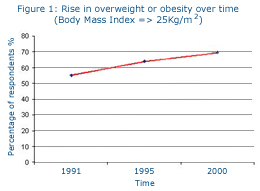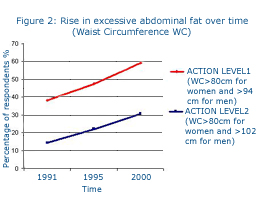Research Findings: Understanding health: Descriptions of health and changes in health over time Summary Papers
Changes in weight and waistlines over 9 years in a Scottish population
 The number of people who are obese and overweight in Scotland has increased significantly over the last two decades increasing the risk of associated conditions such as diabetes, heart disease, cancers and stroke. Developing effective strategies to prevent weight gain and promote weight maintenance is therefore a major public health priority.
The number of people who are obese and overweight in Scotland has increased significantly over the last two decades increasing the risk of associated conditions such as diabetes, heart disease, cancers and stroke. Developing effective strategies to prevent weight gain and promote weight maintenance is therefore a major public health priority.
This study aimed to monitor patterns of measured weight, changes in waistlines and the increase in overweight and obesity over a 9-year period. Focusing on the two older age cohorts from the Twenty-07 Study (aged either 39 or 59 in 1991) and measured their height, waist circumference and weight at three separate intervals 1991, 1995 and 2000. We also looked at changes in body mass index (BMI), over time.
 Only one in five (20%) people maintained a stable weight over 9 years. However, more than 42% of study participants put on 10kg, and 17% gained 5kg. We found that people in early middle age seem to put on more weight, more quickly than older people. But the waistlines of the older group seem to be bigger than those in early middle age. As Figure 1 shows, the proportion of all respondents who were overweight or obese increased from 55% in 1991 to 69% in 2000/04.
Only one in five (20%) people maintained a stable weight over 9 years. However, more than 42% of study participants put on 10kg, and 17% gained 5kg. We found that people in early middle age seem to put on more weight, more quickly than older people. But the waistlines of the older group seem to be bigger than those in early middle age. As Figure 1 shows, the proportion of all respondents who were overweight or obese increased from 55% in 1991 to 69% in 2000/04.
 Similarities in weight gain were found between men and women and similarities appeared no matter what the person’s social class. This suggests weight gain is a widespread problem that crosses all social boundaries.
Similarities in weight gain were found between men and women and similarities appeared no matter what the person’s social class. This suggests weight gain is a widespread problem that crosses all social boundaries.
Waistline measurement may be a better predictor of total body fat than body mass index, because it reflects the mass of intra-abdominal fat. In this study, waistline measures suggest a higher health risk among older subjects than that indicated by BMI. Figure 2 shows the rise in the size of people's waistlines over time that meet action levels associated with increase risk of conditions such as heart disease and diabetes.
 Figure 3 shows a bigger change in waistline measures in the early-middle age cohort compared to the older cohort.
Figure 3 shows a bigger change in waistline measures in the early-middle age cohort compared to the older cohort.
We suggest health promotion strategies to prevent weight gain need to be population-based, targeting all social and age groups, but particularly those in their early middle-age.
Ebrahimi-Mameghani, M. and J. Scott et al. (2007). “Changes in weight and waist circumference over 9 years in a Scottish population.” European Journal of Clinical Nutrition advance online publication 11 July 2007
open access
Blood pressure in young Scots
High blood pressure is an established risk factor for heart disease therefore factors that are associated with blood pressure are important to public health. Low birth weight increases risk of chronic illness in adulthood and birth weight is negatively associated with adult blood pressure. In order to gain a better understanding of the effects of growth patterns on blood pressure we tracked changes in blood pressure through adolescence into adulthood among our youngest cohort from the Twenty-07 Study. We measured the blood pressure, current weight and height of 18 year olds of those who had their blood pressure taken and birth weight recorded at 15. At age 15, systolic blood pressure was associated with body weight and pulse rate.
Changes in blood pressure between 15 and 18 years were found to be related to changes in body weight and body mass index but not height. This pattern reflects the well known relation between growth and blood pressure in adolescents. Weaker associations were found in female adolescents than males because growth had stopped between 15 and 18 years. Birth weight was found to be negatively associated with systolic blood pressure changes between 15 and 18.
Sweeting, H., A. Lever, et al. (1998). "Correlates of blood pressure at age 18 in a cohort of Scottish adolescents." Journal of Epidemiology and Community Health 52(2): 133-4.
pubmed open access

|

|
- Home
- About Twenty-07
- Information for participants
- Information for researchers
- Information on data sharing
- Key People
- Publications
- Contact us
|About Twenty-07 |Information for participants|Information for researchers|Information on data sharing|Key People|Publications|Contact us
Site Credits | Sitemap | News